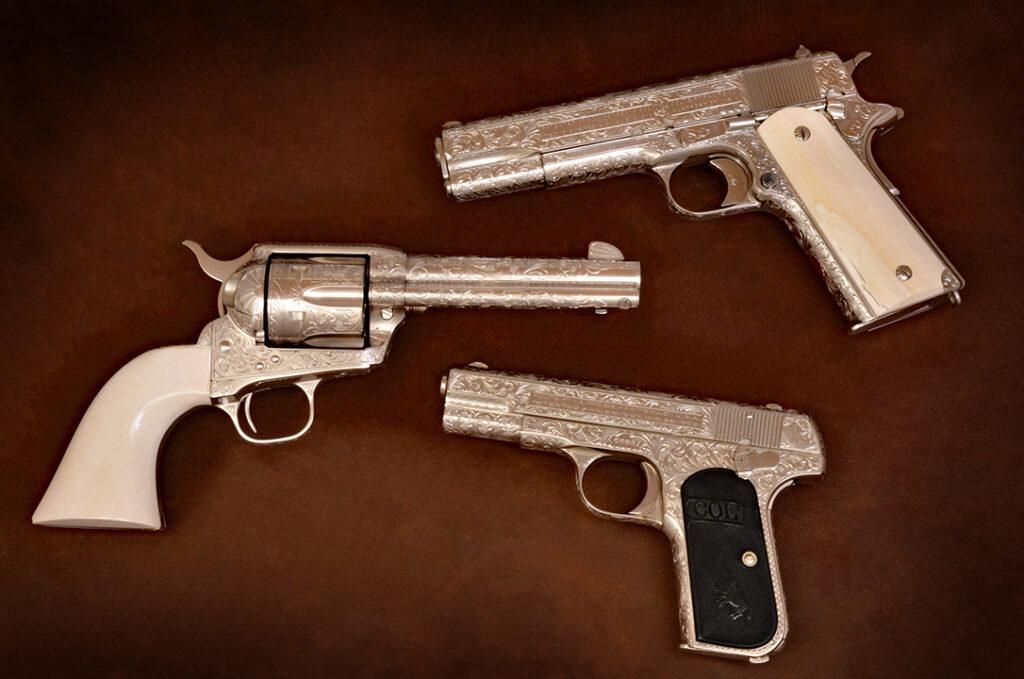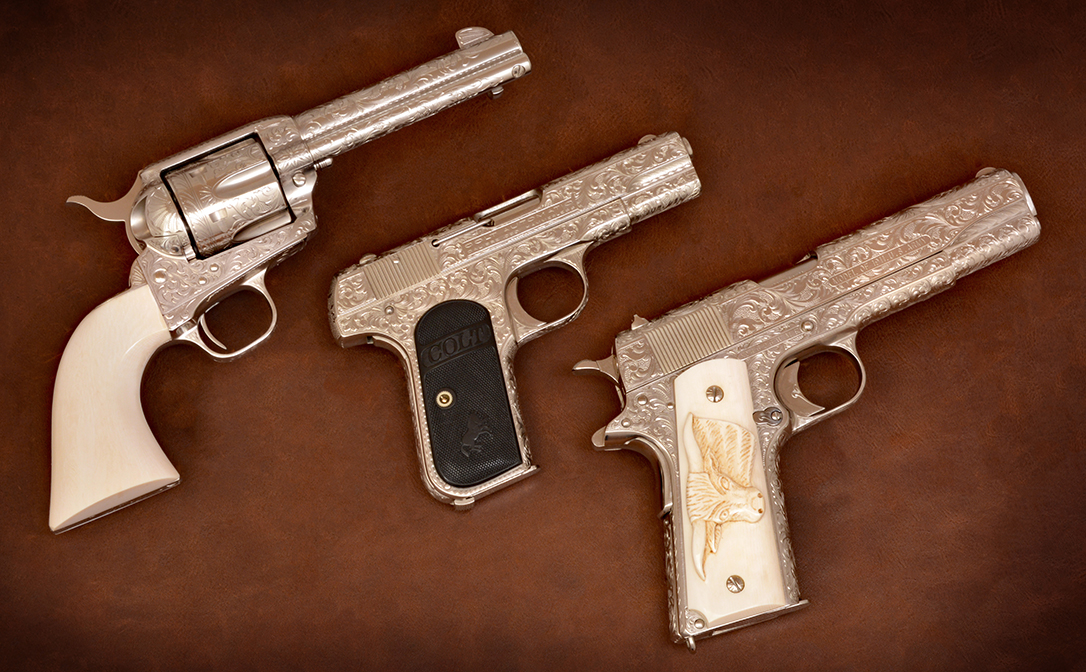Hand engraving firearms is a centuries-old art, one which in its truest form has not changed in almost half a millennium. As noted by late firearms historian R.L. Wilson, in his 1995 book Steel Canvas, “An engraver from centuries past would feel very much at home if he stepped up to a modern workbench to cut a Colt Peacemaker revolver [today].” This is true because the basic hand tools used (hammers, planishers, files, gravers, punches, and calipers) haven’t changed that much since the days of Gustav Young and Louis Daniel Nimschke.
Engraved Colts
And for the most part, when it comes to 19th century firearms (as well as 20th and 21st century versions of historic Colt models) neither have the patterns and styles of engraving used. Pictured below are the actual engraving tools used in the late 19th century by L.D. Nimschke, which are housed in the Metropolitan Museum of Art, and they differ very little from engraving tools used today.
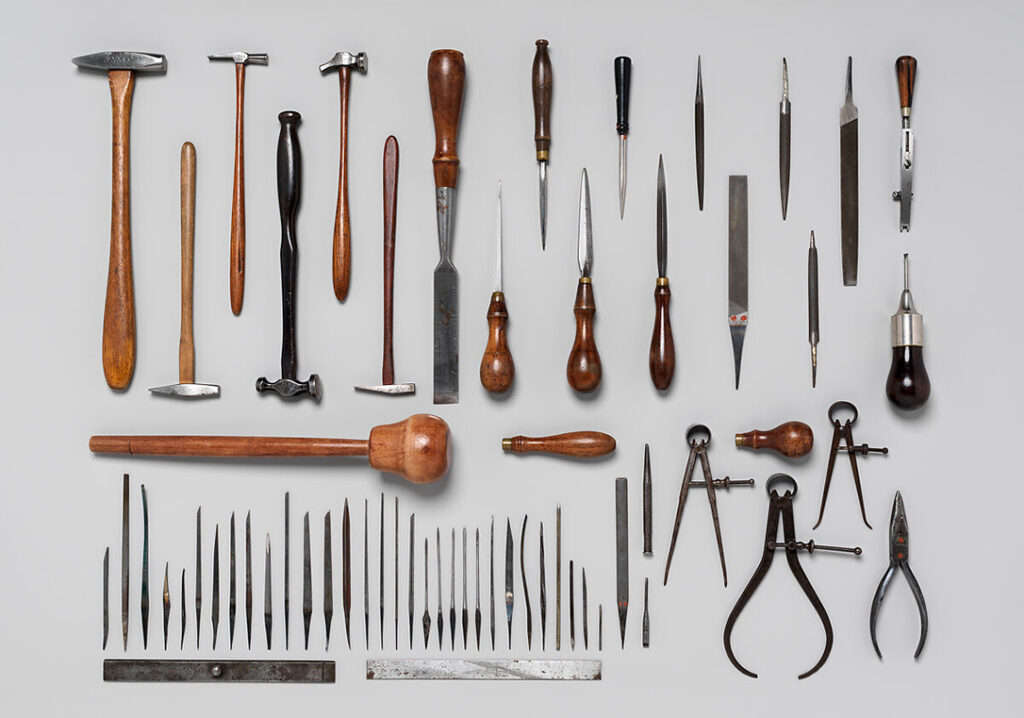
Advertisement — Continue Reading Below
Engraving history by the “book”
The pattern books of 19th century engravers, particularly the works of Gustav Young and Louis Daniel Nimschke, have long been the inspiration for the work of 20th and 21st century engravers, particularly at Colt’s, which brings us to the trio of Colt pistols pictured. Representing three different decades in Colt history, each is engraved in styles with their origins rooted in the late 19th century works of Gustav Young, his successor at Colt’s, Cuno A. Helfricht, and engraver Louis Daniel Nimschke, who established what is known as the “New York Style” of engraving, seen on firearms sold through prominent high-end 19th century retailers Schulyer, Hartley & Graham, and Tiffany & Co.
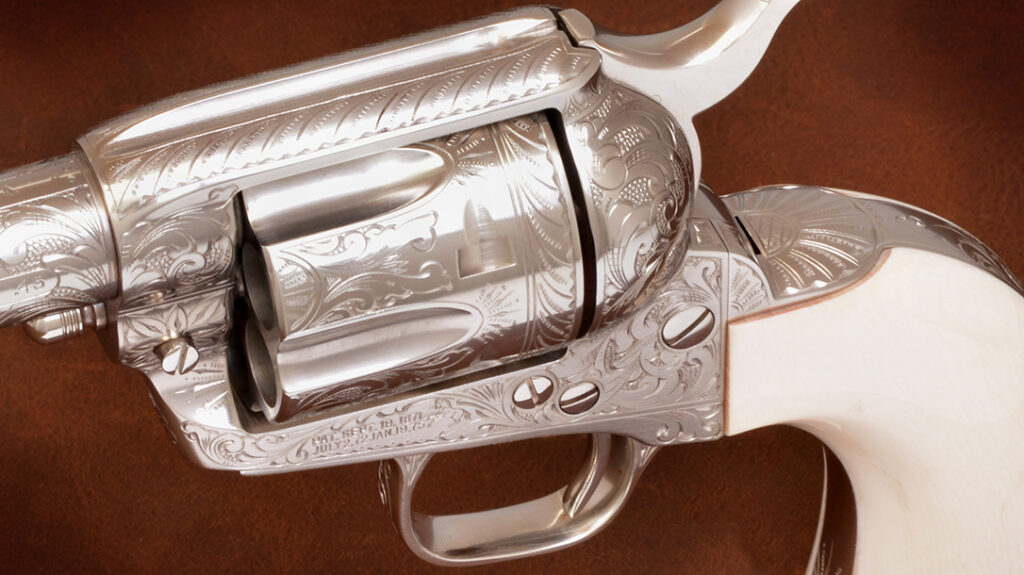
Among Young and Helfricht’s most enduring styles were the prolific use of vine scrolls, leaf designs and variations, such as the popular bank note scroll, all of which were to become hallmarks of both the Young and Helfricht shops at Colt’s. Punch dot backgrounds, a prominent feature in Nimschke-style engraving, were also used to further accent engraving depth and texture. Deluxe presentation models often had engraved screw heads, a little something extra that was not generally done in standard engraving.
Advertisement — Continue Reading Below
In 1869 when Young departed Hartford and moved his family and shop to Springfield, Massachusetts to establish his own independent arms engraving business, Cuno Helfricht would rise to the position of Colt’s chief engraver. Most famously he created the engraving for Colt’s grand display of Peacemakers at the 1876 Centennial Exhibition, pictured below, cementing his place in Colt history. He remained at Colt’s from 1871 to 1921, and that means Helfricht engraved the earliest Colt Model 1911s.
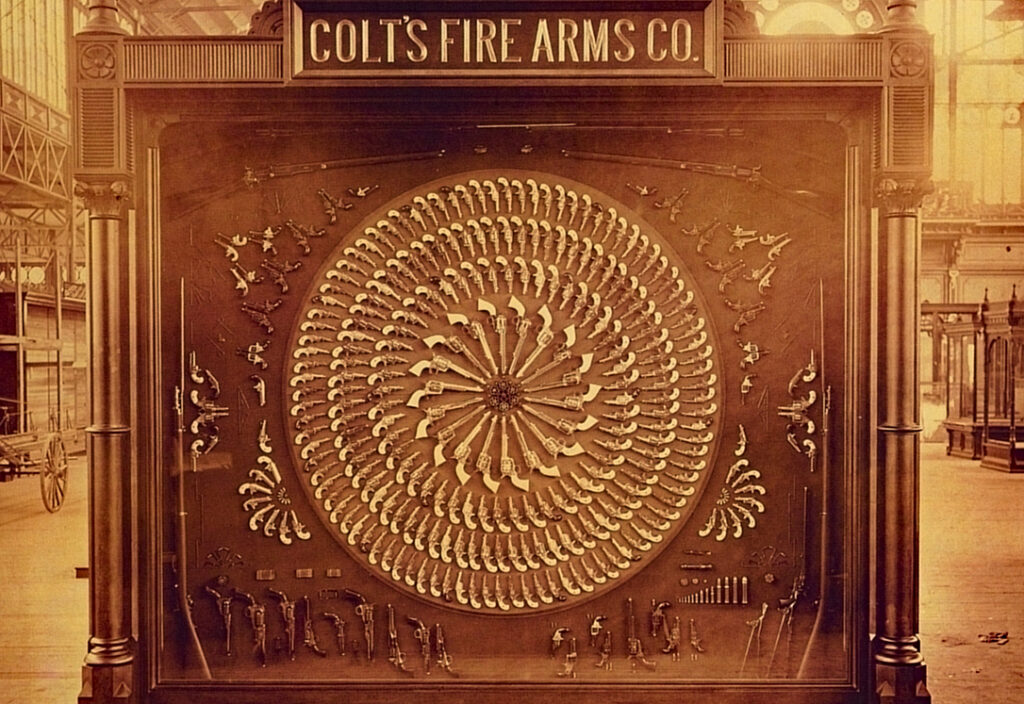
Modern Interpretations
All of the guns featured in this article are recent, “recent” meaning within the last 20 years. They are classic Colt models (not reproductions) that have been period engraved in the styles of Young, Nimschke, and Helfricht.
Advertisement — Continue Reading Below
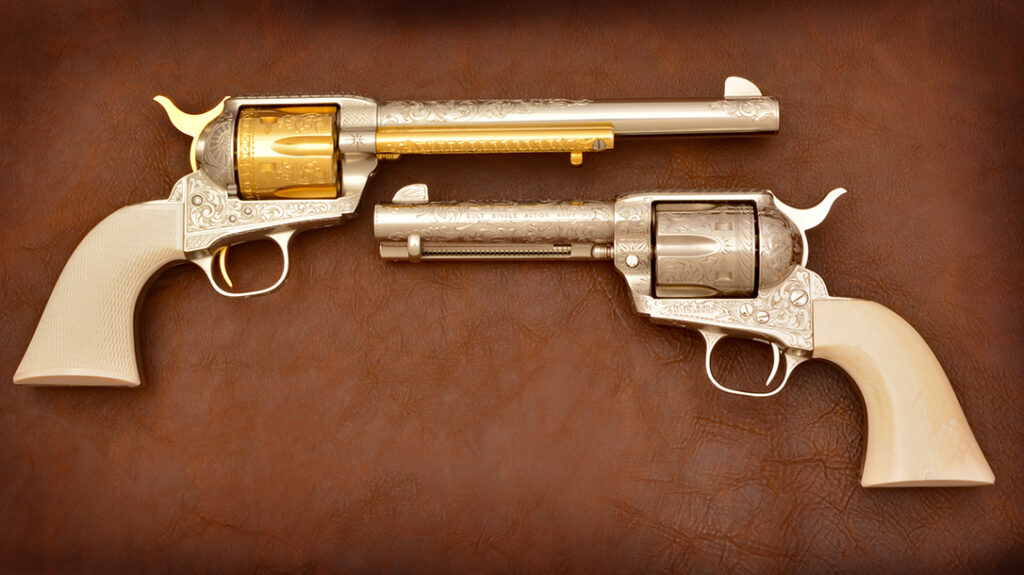
Pictured above are two exceptional examples of modern engraving on Colt Single Actions. Both are done in the Nimschke and Helfricht style by John J. Adams, Sr. (a contract master engraver for Colt from the 1970s to the present). The nickel and gold 7-1/2 inch is an exact copy of a famous Nimschke Colt originally done for Schulyer, Hartley & Graham in the late 19th century; the nickel model with similar engraving is on a 4-3/4 inch SAA. The revolvers also represent two eras in noteworthy Peacemaker design, the top model features an original-style frame c.1873 to c.1891, and the other features Colt’s transverse cylinder latch frame design introduced in 1892.
By 1900 the latter design was listed by Colt’s as “guarantee against smokeless powder,” thus making models produced after 1900 safe to use with modern smokeless powder cartridges. This led to the original Singles Action design, with the cylinder pin held in place by a screw passing through the front of the frame, being called “black powder frame” models. There is, however, one slight caveat, transverse latch Single Actions built from 1892 to 1900 were still restricted to black powder cartridges! It wasn’t until after 1900 and guns with serial numbers above 192000 that the transverse latch models were safe with smokeless cartridges.
Advertisement — Continue Reading Below
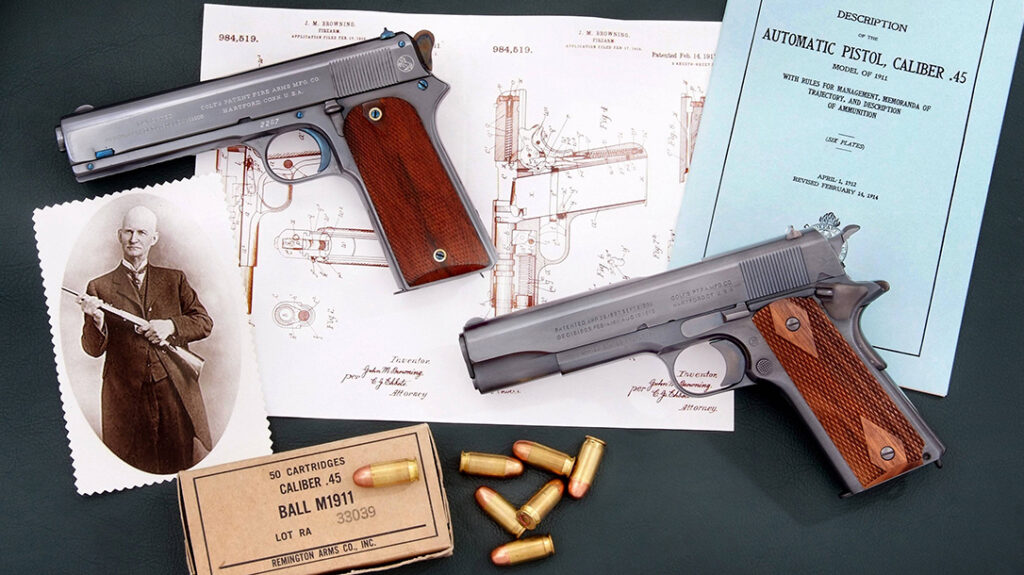
Evolving into the 20th Century
With the exception of a period from WWII up until 1956 (during which SAA production was halted), the Colt Peacemaker has remained the longest running production revolver in history, as well as the greatest symbol of the American West. The creator of that symbol, William Mason, may well have driven the company through the late 19th century, but it was legendary armsmaker John Moses Browning who would propel Colt’s forward into the 1900s by designing a series of modern semi-automatic pistols, as well as the cartridges they would fire.
Pictured above are two examples of Browning’s greatest contributions to Colt history, Model 1905 and Model 1911 .45 ACP semi-autos. Both would evolve from a series of smaller-caliber .38 rimless, smokeless cartridge semi-autos built between 1900 and 1905. Browning also filled the Colt’s catalog with a stunning variety of very popular smaller-caliber models beginning in 1903, with the .32 ACP Hammerless Pocket Automatic.
Advertisement — Continue Reading Below
Measuring just 6-3/4 inches in overall length, 4-1/2 inches in height, 1-inch in width (to the outer edges of the grips; the slide itself was only 0.75 inches in width) and weighing 24 ounces empty, the 1903 could be easily carried in a suit jacket pocket, trouser pocket, or simply tucked into the waistband. Pocket Pistol was a literal definition. The .32 ACP cartridge had been designed by John Browning 1897. It was followed in 1908 by the more powerful .380 ACP version. While we tend to think of the .380 ACP as a German caliber because of its close association to the Walther PPK, it was actually designed by John Browning for Colt and the Model 1908.
.380 Pocket Powerhouse
The .380 ACP Hammerless Pocket Automatic followed the same dimensions as the .32 ACP. And although both were called “hammerless” pistols, they actually had internal concealed hammers, but since there was no external hammer that could be manually cocked, Colt’s designated them as hammerless. In their design, Browning incorporated one of his favorite features, a grip-activated safety. The guns could not be discharged unless firmly grasped in the user’s hand. Both Colt models were discontinued in 1945 but remained in popular use well into the late 20th century.
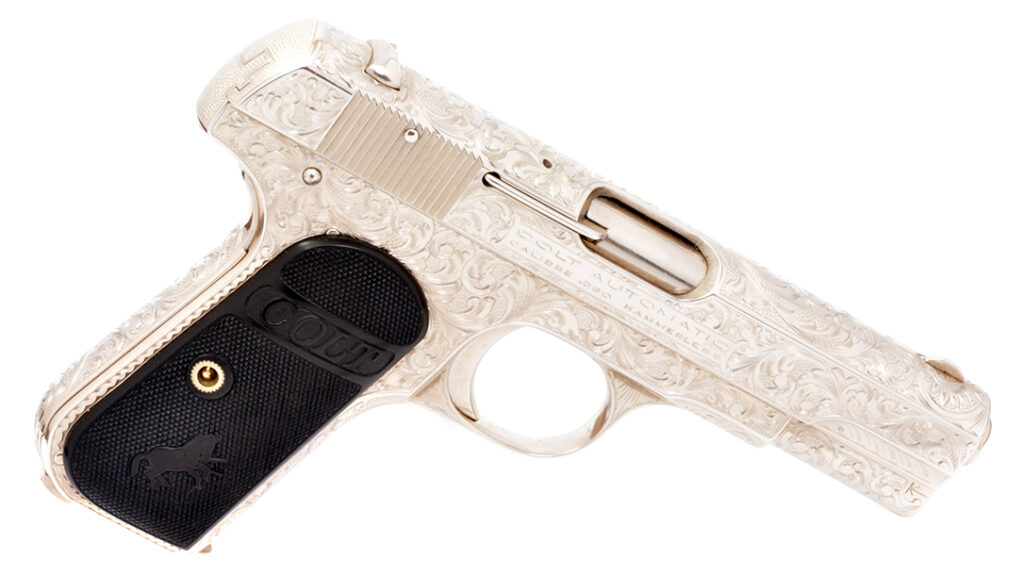
Advertisement — Continue Reading Below
Colt offered the Models 1903 and 1908 in standard blued finish with black, hard rubber grips bearing the “COLT” name and rampant Colt emblem (later changed to checkered walnut grips with the Colt medallion), extra cost ivory or mother of pearl grips; optional nickel plating, factory engraving (as pictured), and special order finishes. The example pictured, originally manufactured in 1922, was hand engraved in 2014 by John J. Adams, Jr. (a Colt factory contract engraver since 1994) in the Nimschke and Helfricht styles to match both the 4-3/4 inch SAA engraved by his father, John J. Adams, Sr. and a Government Model 1911 (Model O) also engraved Adams, Jr.
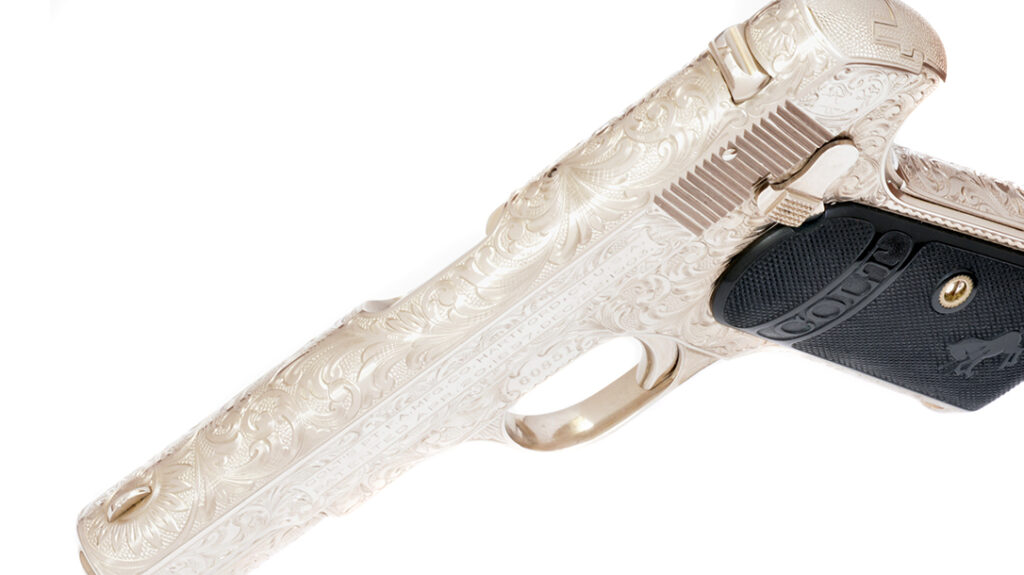
Browning delivers the 1911
Browning had been responsible for one of the earliest small-caliber autoloaders to find favor with lawmen at the turn of the century, the Belgian-manufactured FN Model 1900 chambered in 7.65mm (.32 ACP). At around the same time, Browning licensed his 1897 patent design to Colt’s for that maker’s Model 1900, which was chambered in the new .38 rimless smokeless caliber (originally called a Colt Automatic Pistol Hammerless cartridge or CAPH, later shortened to ACP), a cartridge more closely related to the .38 Long Colt, then in use by the U.S. military for the Colt’s double-action revolver.
Advertisement — Continue Reading Below
Browning had also delivered several .45 ACP models to the U.S. military by 1909, the Model 1905 and further improved Model 1907 (with Browning making changes to the design to meet the specific demands of the Ordnance Department). Although the government’s tests in 1907 were not promising, Colt and Browning reworked the design again in 1909 and once more in 1910. Among the most notable improvements was a change from the double link barrel locking system of the 1905 to a single toggle link that would be used in the Model 1911. For the 1910 military trials Browning and Colt made additional changes to the grip design and angle, which Browning stated would further improve handling.
After an initial field test in February of that year, Colt made a few more modifications, at which point the 1910 looked essentially as would the 1911, with the exception of a thumb-activated safety. A second series of tests were conducted in November, and the military’s Board of Officers rendered a more favorable opinion but presented yet another list of critiques that Colt would have to address. These would lead Browning and Colt’s to the final design for the Model 1911.
Colt M1911 Sets the Standard
On March 3, 1911, the new Colt semi-auto design performed flawlessly, firing 6,000 rounds of ammunition, and addressing all of the Ordnance Department’s concerns, including the addition of an external safety, so the gun could be carried with the hammer cocked (although military protocols stated that the guns were to be carried with an empty chamber). On March 29, U.S. Secretary of War Jacob M. Dickinson approved the selection of the Colt Browning as the “U.S. Pistol, Automatic, Calibre .45, Model 1911.”
Advertisement — Continue Reading Below
It was adopted as the official sidearm of the U.S. Army, Navy, Marine Corps, federal agencies, and remained in continual use until the improved Model 1911A1 was introduced in 1924. The 1911A1 was distinguished by a new style short trigger, larger grip safety and most notably an arched, knurled mainspring housing that fit the palm swell of the shooter’s hand. The new model eventually replaced all of the original military 1911s and became the standard commercial version, although today’s modern 1911s often have the original flat mainspring housing, which has become the more desirable of the two designs.
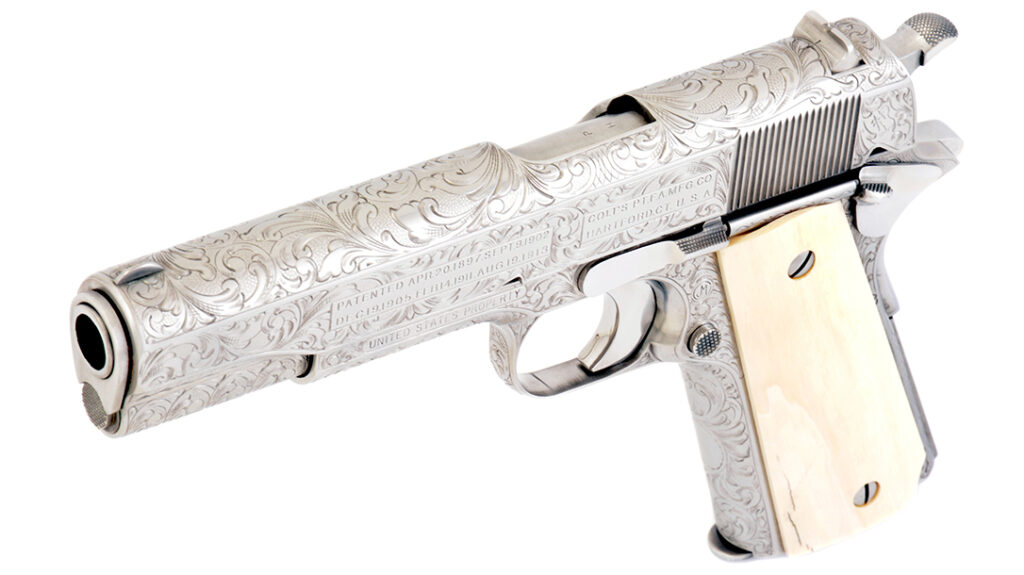
1911 Engraving
The evolution of Colt 1911 engraving styles actually began with the Model 1905. Only six pistols were factory engraved in the series before the 1905 was replaced in 1911 by the new Government Model 1911. According to Wilson, approximately 140 Colt Model 1911 and 1911A1 pre-WWII pistols were factory engraved, and of that number, seven are known to have been gold inlaid. The style of engraving, in keeping with the Helfricht shop, featured scroll and border work. The best models from the factory engravers often had the top and sides of the slide covered with deeply cut and skillfully executed scrollwork.
The sides of the frame, the bottom of the trigger-guard, the bottom of the grip and the mainspring housing were also decorated in a similar scroll pattern. Both the slide stop and safety lock could have light engraving as well, and the edges of the frame above and behind the trigger were finely checkered. The most highly engraved 1911 examples were the Colt National Match .45s, which were produced from 1933 through 1941. Approximately 25 were done with almost full coverage.
The hand engraved, nickel-plated and hand-carved ivory-stocked 1911 pictured above, the third in our American Trio, is highly representative of Colt factory engraving seen on 1911 models from the early1920s (principally the Colt National Match .45s) and showcases styles that are still used to this day by Colt factory engravers. Like the 1873 and 1908 Colts, the engraving incorporates the classic scrollwork patterns and punch dot backgrounds pioneered by the greatest 19th century Colt engravers, making this 20th century gun and the matching 1873 and 1908 Colts not only firearms, but modern works of art.
